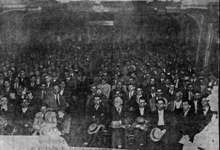Battle of Praça da Sé
With no central leadership, left-wing forces in São Paulo took part in the conflict, which resulted in seven deaths – those of an anti-fascist student, three Integralists, two police officers and a civil guard – and around thirty were wounded.
[1] The battle, as well as the identification of the body of the young militant Tobias Warchavski, triggered a political campaign against the repressive policy of the Getúlio Vargas government.
[4] Although fascism and anti-fascism had clashed in Brazil since the 1920s, with the creation of Brazilian Integralist Action (Portuguese: Ação Integralista Brasileira, AIB) in 1932, the dispute became part of national politics.
[7] Some integralists tried to disrupt the conference but when they noticed the amount of anti-fascist activists there, they withdrew and began to look for reinforcements in the vicinity, and a group of workers repelled them.
[13] The PCB also organized, on August 23, the first large-scale political event sponsored by the Anti-War Committee, the first National Congress Against Imperialist War, Reaction and Fascism.
The event took place at Teatro João Caetano after an assembly and a rally in Cristiano Ottoni Square and a 3,000-strong march along Rua Marechal Floriano Peixoto and Avenida Passos.
At the time, the national leader of the AIB, Plínio Salgado, whose visit had been planned for months by local newspapers, was due to deliver a "doctrinal lecture".
[15] The Union of Employees and Workers of the Noroeste do Brasil Railroad scheduled an extraordinary general meeting (EGM) at 7:00 pm, one hour before the integralist lecture.
At the same time, an integralist parade began and left the association's local headquarters accompanied by drums and taroes, and marchers sought to take Plínio Salgado from the hotel where he was staying to the lecture hall.
[19] The Livraria Elo, on Rua Senador Feijó, the headquarters of the Legião Cívica 5 de Julho, on Rua Anita Garibaldi, the headquarters of the Union of Graphic Workers (Portuguese: União dos Trabalhadores Gráficos, UTG), on Venceslau Brás and the unions in the Santa Helena Building were used as depots where antifascist militants received weapons.
[24] According to Maffei, those who attended the preparatory meetings included Joaquim Câmara Ferreira, Hermínio Sacchetta, Arnaldo Pedroso d'Horta, Noé Gertel, Miguel Costa Jr., Igyno Ortega, Fernando Cordeiro, Leonor Petrarca, Eduardo Maffei and Eneida de Moraes, from the PCB; Marcelino Serrano, Carmelo Crispino, João Cabanas, from the PSB; the anarchists Edgard Leuenroth, Pedro Catalo, Rodolfo Felipe, Oreste Ristori and Gusman Soler; Mário Pedrosa and Fúlvio Abramo, from LCI.
[29] Newspapers reported about the AIB concentrationto commemorate the second anniversary of its creation, and the profusion of manifestos and pamphlets from anti-fascist associations throughout the city had aroused the populace's interest; at noon, large numbers of people occupied the square .
[30] According to Fúlvio Abramo: At this point, four hundred men, belonging to the 1st, 2nd and 6th Infantry Battalions, Fire Department and Cavalry Regiment, already occupied the entire square, under the command of Colonel Arlindo de Oliveira.
About ten minutes later, the Integralists regrouped, and the bulk of them entered the square and stood on the steps of the São Paulo Cathedral, singing their official anthem and giving "anauês".
[32] During the lull that followed this first conflict, most Integralists entered the square behind the cathedral in Largo João Mendes, and appeared at the side of the Santa Helena building.
The bullets hissed in all directions, coming from all over the square, from street corners, from the doors of buildings, where groups of armed people were entrenched and fired at the "green shirts".
Mário Pedrosa was wounded and Décio Pinto de Oliveira, a law student and Communist Youth activist, was shot in the back of the head.
Gusman Soller stated in preparatory meetings the best form of organization against the Integralists would be dynamite, and Edgard Leuenroth said: "only the impediment of the fascist parade mattered".
[37] Others took advantage of the moment to settle accounts with the newly created Federal Police, whose centralized powers took away from the state authorities the relative independence they enjoyed, which deeply irritated the paulistas.
[34] According to A Plebe: Groups of "green shirts" walked down the slopes of Porto Geral, Ouvidor, Rua Líbero, seeking refuge behind cars and in houses.
Fúlvio Abramo and Edgard Leuenroth denied this version, stating the buildings surrounding Praça da Sé had been interdicted by police.
[22] Later, Gofredo Teles Júnior, who participated in the AIB in his youth, minimized the character of the conflict, saying in a 1990 interview with Eugênio Bucci in the magazine Teoria e Debate: There was no confrontation.
[45] In Rio de Janeiro, on October 7, the first issue of the periodical Jornal do Povo was released; it was edited by Aparício Torelly and linked to the PCB.

